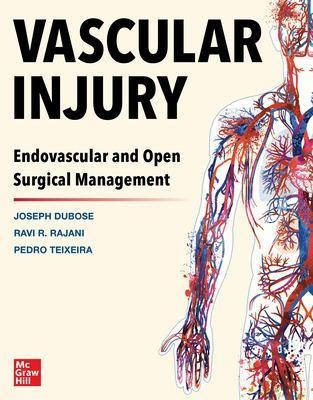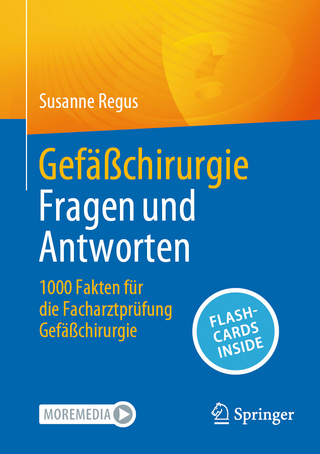
Vascular Injury: Endovascular and Open Surgical Management
McGraw-Hill Education (Verlag)
978-1-264-26982-2 (ISBN)
New technologies have created fresh opportunities to explore improved care options for patients with vascular injuries, and the discipline of vascular surgery is increasingly moving toward wider use of endovascular treatments. This makes collaboration between trauma and vascular specialists more important than ever when diagnosing and managing care of patients with vascular injuries.
Edited by highly experienced, dual-trained trauma and vascular/endovascular surgeons, Vascular Injury: Endovascular and Open Management walks readers through the process of medical, open, or endovascular management of contemporary vascular injury. Detailed description of endovascular technical elements help endovascular specialists adapt their traditional vascular surgery approaches to trauma; at the same time, the book familiarizes trauma specialists with an expanded technical skillset, as well as the strengths/limitations of technologies not provided elsewhere in traditional trauma training. Chapters include:
A brief history of vascular injury – training, diagnosis and management
Contemporary diagnosis of vascular injury
General open vascular repair for trauma
Basics of endovascular trauma management
Endovascular tools and techniques for trauma applications
Vascular damage control
Cervical vascular injury
Upper extremity injury
Axillo-subclavian injuries
Thoracic arch and proximal great vessels
Abdominal aortic and Iliac artery injury
General principles of post-operative management and surveillance
Compartment syndrome in the setting of vascular injury
Solid organ embolization for management of traumatic injury
Hybrid trauma care environments and vascular trauma teams
Chapters include demographics of injury/epidemiology; anatomy; diagnosis; roles of medical management and open intervention; techniques of open exposure and management; role of endovascular intervention; techniques of endovascular exposure and management; roles for anticoagulation and antiplatelets; post-operative care and surveillance.
Joseph J. DuBose, MD, is a dual trained and practicing trauma and vascular surgeon at the University of Texas, Austin, where is a professor of surgery. Dr. DuBose is a retired military surgeon with significant clinical and research experience in the care of vascular injuries. Pedro G. R. Teixeira, MD, is associate professor of Surgery and Vascular Surgery and division chief at the University of Texas at Austin, where he focuses his clinical practice, research activities and teaching in the areas of Vascular Surgery and Trauma Surgery. Ravi R Rajani, MD FACS DFSVS, is chief of vascular surgery at Grady Memorial Hospital and assistant dean for Medical Education at the Emory University School of Medicine.
1. A brief history of vascular injury – training, diagnosis and management
a. Trauma – David Feliciano, University of Maryland
b. Vascular / Endovascular – Joe DuBose, University of Maryland
2. Contemporary diagnosis of vascular injury
a. Vascular / Trauma – David Kauvar – Brooke Army Medical Center
b. Zach Authors – SAMMC Vascular
i. Specifics
1. Physical exam (Hard / Soft signs, ABI)
2. CTA (sensitivity / specificity / limitations)
3. Traditional angiography
4. Ultrasound (Duplex / IVUS)
5. MRA
3. General Open Vascular Repair for Trauma – Principles, Tools and Techniques
a. Trauma – Elizabeth Benjamin – Emory University
b. Vascular – Ravi Rajani – Emory University
i. Specifics of Techniques
1. Basic principles of open vascular operations
2. Basic tools
a. Clamps
b. Fogarty thrombectomy catheters (selection)
c. Suture selection
d. Pledget reinforcement
3. Selection for and conduct of specific techniques
a. Primary repair
b. Patch angioplasty
c. rSVG interposition
d. Synthetic interposition
4. Basics of Endovascular Trauma Management
a. Trauma / Vascular – Megan Brenner - Riverside
b. Endovascular – Yosuke Mastumura / Junichi – Chiba University Hospital, Japan
c. Vascular – Derek Roberts – Ontario Canada
i. Techniques for access
1. Anatomic landmarks at various sites
2. Ultrasound techniques
3. Flouroscopy guided
ii. Sheath types
iii. Wire Options
iv. Catheter Options
v. Access site closure
1. Manual compression
2. Percutaneous closure devices
3. Open closure techniques
5. Endovascular Tools and Techniques for Trauma Applications
a. Trauma / Vascular – Jonny Morrison – University of Maryland
b. Vascular / Vascular – Rishi Kundi – University of Maryland
i. Occlusive Balloons
1. REBOA
ii. Embolic agents and devices
iii. Stents and stent grafts
iv. Basic inventory table
6. Vascular Damage Control
a. Trauma – Matt Bradley – Walter Reed Medical Center
b. Vascular – Joe White – Walter Reed Medical Center
c. Vascular – Todd Rasmussen – Walter Reed Medical Center
i. Specifics
1. Principles – When? Why? – in what situations
2. What? – Open (ligation / shunt) and Endovascular (Balloon occlusion / embolization / temporary stent graft)
a. Shunt types
3. How? - technique description for above
SPECIFIC VASCULAR INJURIES – Secton Editor – Joe DuBose
7. Cervical Vascular Injury
a. Trauma – Eugene Moore / Clay Burlew – Denver General Hospital
b. Vascular – Melanie Hoehn – Denver General
8. Upper extremity injury (Brachial, radial, ulnar)
a. Trauma – Mark Bowyer, USUHS
b. Vascular / Trauma – Sundeep Gilani, University of New Mexico
9. Axillo-Subclavian Injuries
a. Trauma – Tom Scalea – University of Maryland
&n
bsp; i. Richard Betzold, MD – University of Maryland
b. Vascular – Joe DuBose, MD – University of Maryland
i. Anna Romagnoli, MD – Massachusetts General Hospital
10. Thoracic Arch and Proximal Great Vessels
a. Trauma / Cardiothoracic – Jim O’Connor – University of Maryland
b. Vascular / Endovascular – KJ Nagarsheth – University of Maryland
11. Descending Thoracic Aortic Injury
a. Trauma – Demetrios Demetriades – USC / LA County
b. Vascular – Greg Magee, MD
12. Abdominal Aortic and Iliac artery injuries
a. Trauma – Rob Todd – Emory University
b. Vascular – Christopher Ramos – Emory University
13. Mesenteric and Renal artery injuries
a. Trauma – Dave Feliciano, University of Maryland
b. Vascular – Mike Hall, University of Maryland
14. Femoropopliteal artery injuries
a. Trauma – Matt Martin
b. Vascular / Trauma – Mike Sise
15. Arterial injuries below the knee
a. Trauma – Chad Wilson, Baylor
b. Vascular – Joseph Mills / Ramyar Gilani – Baylor College of Medicine
16. Major Truncal venous Injuries
a. Trauma: Joe Galante, UC Davis
b. Vascular: Matt Mell, UC Davis
17. Peripheral Venous Injuries
a. Trauma – Elliott Jessie, Walter Reed
b. Vascular – Brandon Propper, Walter Reed
SPECIAL TOPICS IN VASCULAR INJURY CARE – Section Editor – Pedro Teixeira
18. Complications of vascular injury management
a. Trauma – Carlos Brown – UT Austin
b. Vascular – Lucas Ferrer – UT Austin
i. Notes – identification and management of
1. Infection – imaging, tagged WBC scan utility
2. Access complications / pseudoaneurysms
3. Endoleaks – Types and management in trauma setting
4. Thrombosis – extremity ischemia
5. Disruptions / blowouts (brief key ones) – arterial – enteric fistulas, etc.
19. General principles of post-operative management and surveillance
a. Trauma – Kenji Inaba – University of Southern California
b. Vascular – Brian Knipp – University of Southern California
i. Antiplatelet and Anticoagulation options and choices
ii. Follow-up imaging
1. Ultrasound
2. Contrast enhanced
20. Compartment syndrome in the setting of vascular injury
a. Trauma – Jan Jansen – University of Alabama Birmingham
b. Vascular – Benjamin Pearce – University of Alabama Birmingham
21. Solid organ embolization for management of traumatic injury
a. Trauma – Melike Harfouche, University of Maryland
b. Vascular – Joe DuBose, University of Maryland
22. Pelvic fracture related hemorrhage
a. Trauma – Viktor Reva, Russia
b. Vascular – Chuck Fox, University of Maryland
23. Intercostal vessel hemorrhage management
a. Trauma – Deb Stein, San Francisco General Hospital
b. Vascular – Jonny Morrison, University of Maryland
24. Pediatric Vascular Trauma
a. Pedro Teixeira – UT Austin
b. Vincent Rowe – LA County
25. Hybrid Trauma Care Environments and Vascular Trauma Teams
a. Trauma – Juan Duchesne – New Orleans
b. Vascular - David McGreevy / Tal Horer – Orebro Sweden
| Erscheinungsdatum | 21.07.2023 |
|---|---|
| Zusatzinfo | 75 Illustrations |
| Verlagsort | OH |
| Sprache | englisch |
| Maße | 224 x 282 mm |
| Gewicht | 1091 g |
| Themenwelt | Medizinische Fachgebiete ► Chirurgie ► Herz- / Thorax- / Gefäßchirurgie |
| Medizin / Pharmazie ► Medizinische Fachgebiete ► Urologie | |
| ISBN-10 | 1-264-26982-X / 126426982X |
| ISBN-13 | 978-1-264-26982-2 / 9781264269822 |
| Zustand | Neuware |
| Haben Sie eine Frage zum Produkt? |
aus dem Bereich


